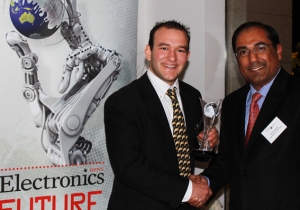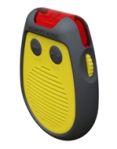Robotics as a technology has highly evolved today, with most of the manufacturing operations in major industries being automated with the help of robots. With the rapidly increasing power of the microprocessor and artificial intelligence techniques, robots have dramatically increased their potential as flexible automation tools. Robots are now able to perform a plethora of activities and handle complex tasks far more easily and reliably and with lesser human intervention. Robotic technology is converging with a wide variety of complementary technologies – such as sensors, positioning technologies, speech recognition and advanced mechanics – to deliver activities that were considered as science-fiction a century ago.
http://www.prlog.org/10940707-robotics-in-industrial-vehicles.html
The next big use of Robotics is in the field of industrial vehicles. Though it is still in its nascent stage, usage of robot-powered vehicles promises to drive industrial automation into a whole new level – similar to what has happened with the introduction of robotics in industrial manufacturing. Robot-powered industrial vehicles can automate the material handling and transport requirements for industries, especially in those industries that deal with hazardous machines, poisonous or dangerous substances, heavy materials or unpleasant work environments.
Characteristics of Robotic Vehicles
- Built-in Intelligence: The Intelligence in the robots resides in the control systems, which are basically embedded microprocessor or microcontroller-based systems. The consistency of Moore’s law over the years has resulted in the development of microprocessors (and microcontrollers) having exceptional processing power – apt for managing large industrial vehicles. These microprocessor-based embedded applications can imbibe complex logic into the robot’s operations, enable quicker response times and ensure that they carry out the desired tasks easily and effectively.
- Manoeuvring and Positioning: Most vehicles today employ electronic control mechanisms such as power steering, automatic gear systems, electronic acceleration and braking systems, etc. This facilitates easier interface-ability with robotic systems to achieve the desired operation. Though this process presents its own set of challenges, with the current technological advancements, solutions are highly achievable and practical too.
Real−time and accurate positioning of vehicles in industrial worksites is a key issue in the use of autonomous systems, for both safety and efficiency reasons. Various types of sensors and methods can be used to achieve this goal. Global Positioning System (GPS) can be the best solution for open locations covering large areas. For closed and underground operations, Wi-Fi, ZigBee or laser-based systems can be highly effective. The Wi-Fi and ZigBee technology is being widely used in closed environments, as it is easy to set up and requires little LX Group Hardware Development. Besides aiding positioning, Wi-Fi and ZigBee-based systems are useful in the exchange of data with robots.
- Sensors: Sensors form the eyes and ears of the robots. Improvements in instrumentation have led to the development of rugged and heavy-duty sensors that can withstand and operate in the harshest of environments. The dependability of the sensors plays a great role in ensuring error-free operation of the robots. Robust Light and Laser-based sensors, video cameras, pressure sensors, odometers and proximity sensors can all be integrated to ensure that the desired autonomous navigation of the vehicles is achieved seamlessly.
- Interoperability: The greatest benefit of a microcontroller-based system is the ease with which interoperability can be achieved between robots. In a multi-machine environment, this is highly crucial. The information on the operation readiness or completeness can be a trigger for the operation – such as loading a robot-guided truck by a robotic crane.
- Control Centre: The Robotic vehicles can be managed using a control centre. The area to be served or the route map can be designed and maintained centrally and be transmitted to the robotic vehicles as required. The control centre also helps in strategically locating the vehicles for optimal operational efficiency.
Benefits Of Using Robots In Industrial Vehicles
• Increased Productivity
Robotic vehicles can operate at peak rates for an entire shift improving productivity
• Improved Reliability
Microprocessor-based robotic systems ensure higher reliability
• Safety
Capability for remote monitoring and control guarantees higher safety for personnel
• Enhanced Precision
Use of microprocessors in conjunction with advanced sensors improve precision
• Environments
Robotic vehicles can operate in a vast range of climate, temperature and environments
• Increased Flexibility
Operational instructions can be modified as required, increasing flexibility
• Lesser Cost
Automation reduces direct labour costs and related expenses
Challenges of Using Robotic Industrial Vehicles
• Unstructured Terrain
Uneven or treacherous terrain with the full richness of a natural setting
• Range of Tasks
The range of tasks performed by the machines may be quite large which can increase the automation requirements
• Unpredictable Conditions
Weather conditions can be highly variable and unpredictable and may require the machines to operate in rain, snow, fog and dust
• Instrumentation Challenges
Sensors used must be able to sustain the harsh environment and be rugged
• Uncontrolled Work Environment
Unauthorised people, animals or other machines can enter the environment
The Implementation
The benefits that implementation of robotics in industrial vehicles provides are huge, and so are the challenges to its implementation A robotic vehicle might have to face a typically adverse environment, and seemingly simple obstacles can pose a serious challenge as far as movement of vehicles are concerned. A list of challenges that a robot has to face in an industrial environment is provided in the section “Challenges of using robotic industrial vehicles”.
Though the challenges may seem Herculean, the solution is far easily achieved if we break the problem and address them individually as described below.
- Study the condition: The external mobile machines employed in industrial tasks operate in a specific context (a mine, a farm or any other industrial location). Identifying the materials that the machine has to handle, the terrain in which the machine would operate, and the expected obstacles can facilitate planning and implementation of the control system.
- Scope the requirement: In an industrial environment, the machines are likely to engage in repetitive tasks. The set of activities can be broken down and the scope of each activity can be defined to reduce the complexity. For example, a robot used for underground mining would deal only with drilling and excavation, and another robot would be used to handle transportation-related tasks. This factor reduces the need for sophisticated planning.
- 80/20 rule: Robots can be designed incorporating the conventional 80/20 rule. Automation can handle 80% of the tasks that are redundant and structured, while a technician performs the remaining 20% that may be unstructured or may require ad-hoc decision-making. This not only improves productivity but also enhances reliability of the whole operation.
APPLICATION OF ROBOTIC INDUSTRIAL VEHICLES
• Mining Industry
Continuous mining for underground vehicles
• Manufacturing Units
Transportation of goods and materials
• Farming
Autonomous Tractors
• Hazardous Substances
Transportation of hazardous materials
• Interplanetary Exploration
Vehicles used for Inter-planetary explorations
Conclusion
Leaders in most industries consider industrial robots as key elements in their manufacturing and business strategies. World over, manufacturing units are recognising and reaping the benefits of robotics in multiple aspects – productivity, flexibility, quality, time to market – enabling them to have competitive advantage. Robotics is no longer considered only as a mere stationary replacement for workers in a factory. The use of robotics to automate industrial vehicles can be considered as a huge step forward in achieving seamless automation of the entire industrial operation. And as far as the potential of robotics is considered, we still may be scratching on the tip of an iceberg!
About LX Group
LX Group is an award winning electronics design company based in Sydney, Australia. LX Group Services include full turnkey design, electronics, LX Group Hardware Development, software and firmware design. They specialise in embedded systems and wireless technologies design.
LX Group offers clients a range of professional solutions designed to take a new product idea from concept through to production and beyond. LX focuses on fully understanding all aspects of a client’s requirements (both technical and business) and works on creating custom-made solutions. LX Group’s expertise in developing electronic products enables a quicker design process and reduces cost in bringing a concept to reality. http://www.lx-group.com.au
 Download PDF Format
Download PDF Format
Published by LX Pty Ltd for itself and the LX Group of companies, including LX Design House, LX Solutions and LX Consulting, LX Innovations.
 For the second year running, LX Group has won a major award at the Electronics Future Awards 2010.
For the second year running, LX Group has won a major award at the Electronics Future Awards 2010. is received. In the event of an emergency, authorities may decide to send an alert by creating a message and alert tone package, which sends out an immediate radio broadcast. If contact it lost with the registered radio station, Yellow Bird will notify the user and scan for alternative stations.
is received. In the event of an emergency, authorities may decide to send an alert by creating a message and alert tone package, which sends out an immediate radio broadcast. If contact it lost with the registered radio station, Yellow Bird will notify the user and scan for alternative stations.
 Uncategorized |
Uncategorized | 
 Posted by LX Group
Posted by LX Group 